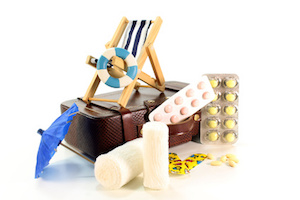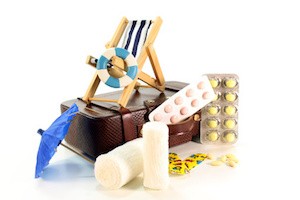No one likes feeling under the weather, and when you are overseas in a fun or exotic spot, it is even more important to feel your best.
When you are packing for a trip, consider taking a supply of first aid items so that you can nip bugs and small injuries in the bud quickly. Consult your GP or pharmacist, depending on your destination.
Any medicines, whether over the counter or prescribed, should be kept in their original packaging in your checked baggage (unless you have a condition which requires medication in transit). There may be restrictions taking some items to certain countries.
Regardless of your destination, always have comprehensive travel insurance, in case a health problem or accident affects your travels.
In terms of general first aid – here are some ideas:
Sunscreen
In New Zealand we are accustomed to slip, slop, slap and wrapping, but the sun burns all over the world. Have a good supply of sunscreen and apply it liberally and often. The effectiveness of the sunscreen will wear off naturally with sweating and water exposure, so reapply every couple of hours. Apply sunscreen as a matter of course each morning – you eve know where your travels will take you and when you may be caught out in the sun for longer than expected.
If you do get a typical sunburn, you will have tender redness and superficial peeling. These don’t usually require specialised treatment. Keep your skin clean, avoid the sun or cover the area well with clothing and consider taking a low dose of ibuprofen or paracetamol if the discomfort is too much. Drink plenty of water to combat dehydration associated with a burn.
Seek professional help if blisters appear: On rare occasions, severe sunburn can lead to large blisters and more significant skin breakdown. When this happens, a qualified medical professional should be engaged to apply simple dressings and wound care.
Traveller’s Tummy
A supply of an over the counter treatment like Imodium can help relieve the symptoms of diarrhoea. Ask your doctor about taking a supply of antibiotics if you are travelling to a destination notorious for diarrhoea, where medical assistance may be hard to obtain.
Avoid diarrhoea by staying clear of tap water (including teeth brushing) and avoiding the following foods and drinks. Always wash your hands well before meals:
- Dairy products
- Salads and raw vegetables, especially leafy greens
- Raw seafood
- Under-cooked meat
- Condiments, such as salsas sitting on a restaurant counter top
- Ice (freezing does not kill bacteria)
Seek medical assistance if diarrhoea involves children, lasts more than three days, it gets bloody, or you get dehydrated and cannot take oral fluids.
Vaccinate
Talk to your GP about any destination-appropriate vaccinations and ensure yours are up to date.
Motion sickness
Again, there are plenty of over the counter remedies, but if you suffer severe motion sickness, consult your doctor for other alternatives. Before travelling, take a dose before leaving so you can see how the medication affects you. Remember you should not drive a car or operate machinery while on certain medications.
To help prevent motion sickness
Limit alcohol and caffeine, drink plenty of water and try to plan your seating arrangements to prevent motion sickness. When on a plane, try to sit over wing. If driving, sit in the front seat. If on a train, sit facing forward.
Limit sensory input by closing eyes or looking out towards horizon. Avoid reading.
Bites and stings
If you travel to an area with jellyfish or bug risk, you will need:
- Gloves
- Forceps or tweezers (to remove stingers)
- 1% hydrocortisone cream
- Antihistamine
- Repellent
If you are stung, try and note what sort of critter it was, it may help with treatment.
Try not to rub or scratch the area as that can trigger further reaction.
Apply ice to the area for pain relief.
Check with the local medics to find out if antivenin is necessary and available at your location.
Apply a topical cream and take an antihistamine pill to alleviate the symptoms.
Blisters
Blister seem harmless, but if you are on your feet all day, they can cause a lot of misery. Blisters can appear where backpack straps rub, in shoes and many places in between. Pack saline to clean them out and plenty of clean gauze, bandages or sticking plasters.
The best thing to do with a blister is usually to leave it alone and let it heal naturally, but do seek help if the area becomes painful, red, swollen, or develops a discharge, as these may be signs of infection.
Deep Vein Thrombosis
It’s important to remember that anyone can get a Deep Vein Thrombosis and they are potentially life threatening. Certain people are more at-risk. These people include:
- Those with a personal or family history of blood clots
- Recent surgery or injury (especially if it limits mobility)
- Older age
- Obesity
- Patients with active cancer
- Pregnant women
- Use of birth control or hormone-replacement therapy
- Any person whose mobility is limited.
If you have one of the above risk factors above, your doctor may recommend compression stockings or medication to reduce your risk of developing a blood clot.
Keep hydrated and move every two or three hours. Familiarise yourself with exercise to prevent DVT and practice them regularly in flight.
If you develop pain, swelling and/or redness in one of your legs, have recently travelled and are having difficulty breathing, chest pain, lightheadedness, fainting, coughing up blood or fast heart rate, call an ambulance immediately.










Join the Discussion
Type out your comment here:
You must be logged in to post a comment.